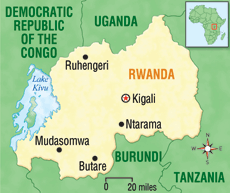Tuesday, June 2, 2009
Pentecost
Last Sunday was Pentecost, which is a huge deal in a town where pretty much everything is run by the Catholic Church (not to mention that 56.5% of Rwandans are Roman Catholic according to official numbers.) Since we got here, there has been a wooden frame structure next to the primary school that we have been curious about (it is for farming? for animals?) As we found out on Sunday, it is our village’s version of a stadium. On Sunday, tarps (including one from the UN’s World Food Programme) were laid over the top to protect from sun and rain, and all the church officials and local dignitaries sat under this outdoors enclosure. Down below this pseudo-stage, the church members were barricaded from the front by wooden fences much like an outdoor summer concert would have barricades to keep fans from rushing the stage (more than once, with all the dancing and singing, I felt like I was at a concert). While Pentecostals are known for their ridiculously long church services here, the normal Catholic service doesn’t last any longer than it would in the United States, but Pentecost is different. Sunday’s service stretched on for four hours, which made me thankful that I was on the stage with seating and shade. To combat the sun, a mass of rainbow-striped umbrellas were unfurled by the worshipers, creating quite the colorful spectacle. The stage itself, in addition to boasting seating for the who’s who of our village, included a choir clad in white robes, a group of followers to be confirmed (or at least what I think was confirmation), three acolytes in white and red robes and the alter itself. The entire place was decked out in full Pentecost decorations (white and red everywhere), including yellow flags with a red heart with a sword through it. The alter linens, bible, candles, and communion tools were much like that found in any Catholic church. As one would expect, there is no organ or keyboard here, BUT there were two electric guitars, a traditional drum, and a complete sound system that relayed the words of the priest as well as the choir’s songs to the people. Raised in the Episcopalian church, and given that much of the Episcopalian and Catholic service is the same, many elements and prayers were familiar to me (albeit in a different language), though the singing was much rowdier than I remember from any church service of my past. Markedly different than the traditional church service, though, were the communion and offering, during which huge containers of holy wafers (but no wine) and, in the case of the offering, huge woven baskets, were distributed to the people by over 20 alter helpers. This was mainly out of necessity, as the nuns later told us there were over 1,000 people there.
Subscribe to:
Post Comments (Atom)


No comments:
Post a Comment